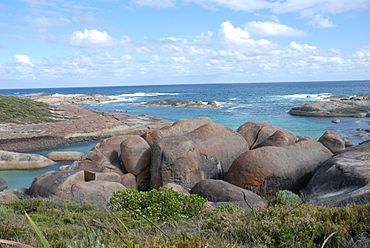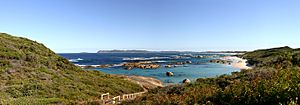William Bay National Park facts for kids
Quick facts for kids William Bay National ParkWestern Australia |
|
|---|---|
|
IUCN Category II (National Park)
|
|

Elephant Rocks
|
|
| Nearest town or city | Denmark |
| Established | 1971 |
| Area | 17.34 km2 (6.7 sq mi) |
| Managing authorities | Department of Parks and Wildlife |
| Website | William Bay National Park |
| See also | List of protected areas of Western Australia |
William Bay National Park is a special natural area in Western Australia. It's about 369 kilometers (229 miles) southeast of Perth. You can find it between the towns of Denmark and Walpole. This park is part of the beautiful Great Southern region.
Contents
Discover William Bay National Park
William Bay National Park is located about 15 kilometers (9 miles) west of Denmark. It covers a large area of 1,734 hectares (4,285 acres). Inside the park, you'll find famous spots like Greens Pool and Elephant Rocks.
Amazing Rock Formations and Beaches
At Greens Pool, huge granite boulders form a natural barrier. This barrier protects the pool from the big waves of the Southern Ocean. It makes Greens Pool a very safe place for kids to swim, especially with adults watching. The park is along the south coast of Western Australia, part of what's called the Rainbow Coast. It's also within the Shire of Denmark.
The park has many different types of nature. You can see areas with peppermint trees and thick heathland plants. There are also small forests of karri trees and eucalyptus woodlands. The park includes Parry Inlet, several lakes, and tall hills with granite rocks.
Coastal Wonders to Explore
On the eastern side of the park, you'll find popular coastal areas. These include Greens Pool, Elephant Rocks, Madfish Bay, and Madfish Island. There's also a lovely spot called Waterfall Beach.
The western side of the park has wilder, less crowded coastal features. These include Parry Beach, Parry Inlet, Mazoletti Beach, and Hillier Bay.
Fun Activities in the Park
Many people enjoy fishing from the rocks and beaches here. You might catch different types of fish like King George whiting, herring, Australian salmon, and mulloway.
Bushwalking is another popular activity. There are many walking tracks around the park. These tracks offer amazing views of the coast and the natural surroundings.
History of the Park
The land where William Bay National Park now stands has a long history. The Mineng people are the traditional owners of this area. They are Aboriginal Australians who have lived here for a very long time, possibly between 40,000 and 50,000 years.
Ancient Discoveries
Evidence of their long history has been found in the park. Stone tools and other items have been discovered at places like Lights Beach, Lake Byleveld, and Parry Inlet. These finds show how important this land has been for many generations.
How the Park Got Its Name
William Bay was named in the 1830s by a person named John Septimus Roe. He named it after Sir William Edward Parry, a famous British explorer. Two other nearby places, Parry Inlet and Edward Point, were also named after him.
The area officially became a national park in 1971. At that time, it covered about 4,644 acres. Later, in the 1980s, a small area near Lake Bylveld was added to the park.
A Popular Place to Visit
William Bay National Park is a very popular spot for tourists. Many people come to enjoy its beauty each year. For example, over 238,000 visitors came to the park in 2014–2015.
Animals You Might See
William Bay National Park is home to many different animals, especially birds.
Birds of the Park
You might spot several types of honeyeaters flying around. Other birds found here include:
Some special waterbirds also visit the park. These are migratory birds, meaning they travel long distances. Some of these birds are considered threatened, which means their numbers are very low. They include the Australasian bittern, hooded plover, and little bittern.
Unique Spiders
In 2008, scientists found a very rare and ancient spider living in the park. This spider is called an assassin spider. It is also listed as a threatened species, making its discovery in the park very important.
See also
 In Spanish: Parque nacional William Bay para niños
In Spanish: Parque nacional William Bay para niños



